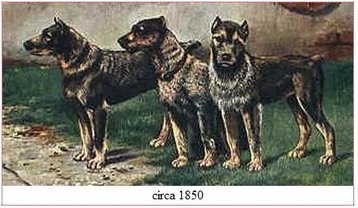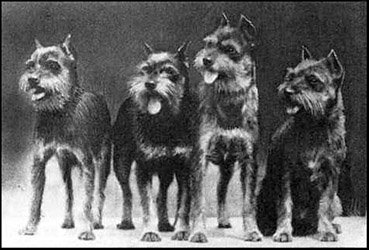The History of Schnauzers and Pinschers
The dog (Canis familiaris) is one of the oldest domesticated animals, living in symbiosis with humans and continuously increasing its utility in human service. Purebred dogs are bred for their hereditary traits, primarily for pleasure and necessity. For thousands, and indeed millions of people worldwide, showcasing dogs at exhibitions is a passion, where external beauty and internal, psychological traits play a decisive role in competition. Above all, however, we all seek a friend in our dogs.
Origin, Based on Official Standard Descriptions
The German (Standard) Pinscher
At the beginning of the FCI Standard No. 184, the breed's origin is described as follows: "A representative of an old breed, which first appeared in German studbooks in 1880. It shares common ancestors with the Schnauzer, as the Schnauzer was once called the wire-haired Pinscher. The smooth-haired Pinscher differs from the wire-haired variety in its color and short coat. At one time, most of them were black with light brown markings, but they also appeared in a variety of colors, from brown to reddish shades, salt-and-pepper, or simply bluish-gray to black."
The Giant Schnauzer
The FCI Standard No. 181 for the Giant Schnauzer states: "Originally used in southern Germany as a cattle driver. Around the turn of the 19th to the 20th century, purposeful breeders noticed that it was exceptionally suitable for work and possessed valuable traits. It was introduced into studbooks in 1913 and recognized as a working dog from 1925."
The (Standard) Schnauzer
In the introduction of the FCI Standard No. 182, the (Standard) Schnauzer is described as follows: "Originally, the Standard Schnauzer was kept around stables in southern Germany, particularly among horses. It diligently hunted rodents, killing them on the spot, earning it the nickname 'rattler' in common language. When the German Pinscher-Schnauzer Club was founded in 1895, it was registered as the wire-haired Pinscher."
The Miniature Schnauzer
The FCI Standard No. 183 for the Miniature Schnauzer states: "Around the turn of the 19th to the 20th century, the Miniature Schnauzer was known as the wire-haired Miniature Pinscher in the Frankfurt/M. area. It was no easy task to develop a small-bodied dog breed from individuals of varying shapes, sizes, and coat types (hard, soft, or silky) that would closely resemble its larger counterpart, the Standard Schnauzer, in nature, appearance, and behavior."

Source: http://www.kaiteriteri.net
From the Above, the Following Overview Can Be Compiled
The breed group has two main branches: the Pinschers and the Schnauzers. Historically, the Pinschers predate the Schnauzers, but due to their popularity in Hungary, the Schnauzers are mentioned first. It is also noteworthy that the breed club, the Hungária Schnauzer and Pinscher Club, placed the Schnauzer first in its name when it was founded over 20 years ago.
The Schnauzer and Pinscher breed group offers a wide variety: three size and four color variants for Schnauzers, and two size variants for Pinschers. With such a wide selection, anyone can find the variation that best suits their preferences in terms of color, size, and coat quality.
Size and Color Variants
The Giant Schnauzer, standing 60-70 cm tall and weighing 35-45 kg, and the Standard Schnauzer, standing 45-50 cm tall and weighing 15-20 kg, come in black and salt-and-pepper colors. The Miniature Schnauzer, standing 30-35 cm tall and weighing 4-8 kg, expands the color palette to include white and black-and-silver, compared to the larger variants.
For Pinschers, the Standard variant stands 45-50 cm tall and weighs 14-20 kg, while the Miniature variant stands 25-30 cm tall and weighs 4-6 kg. Most Pinschers are short-haired and require no grooming, with two color variants recognized: black-and-tan and solid fawn. All variants share the typical traits of a calm yet lively temperament, playfulness, and trainability.

Source: http://www.kaiteriteri.net
Schnauzer or Pinscher, Pinscher or Schnauzer?
The history of the breed group's variants has long been intertwined, and for a long time, they were considered the same breed: Schnauzers were initially called wire-haired Pinschers. The variants are often traced back to the so-called 'peat dog,' but we might be closer to the truth by stating that these breeds emerged in the late 19th century from the multitude of dogs found on German farmyards.
